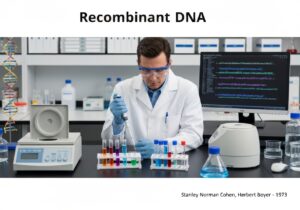In 1921, Frederick Banting and Charles Best, under John Macleod’s direction at the University of Toronto, isolated insulin from canine pancreatic extracts. Biochemist James Collip then developed a purification process, making the extract safe for human use. This discovery transformed type 1 diabetes from a fatal disease into a manageable condition, earning Banting and Macleod the 1923 Nobel Prize.
Discovery and Isolation of Insulin
- Frederick Banting
- Charles Best
- John Macleod
- James Collip
Before 1921, a diagnosis of type 1 diabetes was a death sentence, often within months. The prevailing theory, proposed by researchers like Oskar Minkowski and Joseph von Mering in 1889, linked the pancreas to diabetes by showing that its removal in dogs induced the disease. The challenge was to isolate the specific anti-diabetic substance from the pancreas without it being destroyed by the organ’s own digestive enzymes. Frederick Banting, a young surgeon, hypothesized that ligating the pancreatic ducts would cause the enzyme-producing acinar cells to atrophy, leaving the islets of Langerhans, which he believed produced the sought-after secretion, intact. He proposed this idea to John Macleod, a prominent physiologist at the University of Toronto. Macleod was initially skeptical but provided Banting with lab space, ten dogs, and the assistance of a medical student, Charles Best. Over the summer of 1921, they successfully induced diabetes in dogs by removing their pancreas and then treated them with an extract from the degenerated pancreases of duct-ligated dogs. The extract, which they called “isletin,” effectively lowered blood glucose levels. The next crucial step was purification. Biochemist James Collip joined the team and developed a Verfahren using alcohol extraction to produce a purer, less toxic form of the extract suitable for human trials. The first human patient, 14-year-old Leonard Thompson, was successfully treated in January 1922, marking a turning point in medical history.
Typ
Unterbrechung
Verwendung
Vorläufersubstanzen
- discovery by Oskar Minkowski and Joseph Von Mering that pancreatectomy causes diabetes (1889)
- identification of the islets of langerhans by Paul Langerhans (1869)
- suggestion by Edward Albert Sharpey-Schafer that a single chemical from the pancreas, which he named “insuline,” was responsible for glucose control (1916)
- unsuccessful attempts by Georg Ludwig Zuelzer and others to create pancreatic extracts
Anwendungen
- treatment of type 1 diabetes
- development of various insulin formulations (short-acting, long-acting)
- management of hyperglycemia in type 2 diabetes
- treatment of hyperkalemia
- foundational research in endocrinology
Patente:
- US1469994
Mögliche Innovationsideen
!Professionals (100% free) Mitgliedschaft erforderlich
Sie müssen ein Professionals (100% free) Mitglied sein, um auf diesen Inhalt zugreifen zu können.
VERFÜGBAR FÜR NEUE HERAUSFORDERUNGEN
Maschinenbauingenieur, Projekt-, Verfahrenstechnik- oder F&E-Manager
Kurzfristig für eine neue Herausforderung verfügbar.
Kontaktieren Sie mich auf LinkedIn
Integration von Kunststoff-Metall-Elektronik, Design-to-Cost, GMP, Ergonomie, Geräte und Verbrauchsmaterialien in mittleren bis hohen Stückzahlen, Lean Manufacturing, regulierte Branchen, CE und FDA, CAD, Solidworks, Lean Sigma Black Belt, medizinische ISO 13485
Wir suchen einen neuen Sponsor
Ihr Unternehmen oder Ihre Institution beschäftigt sich mit Technik, Wissenschaft oder Forschung?
> Senden Sie uns eine Nachricht <
Erhalten Sie alle neuen Artikel
Kostenlos, kein Spam, E-Mail wird nicht verteilt oder weiterverkauft
oder Sie können eine kostenlose Vollmitgliedschaft erwerben, um auf alle eingeschränkten Inhalte zuzugreifen >Hier<
Verwandte Erfindungen, Innovationen und technische Prinzipien











